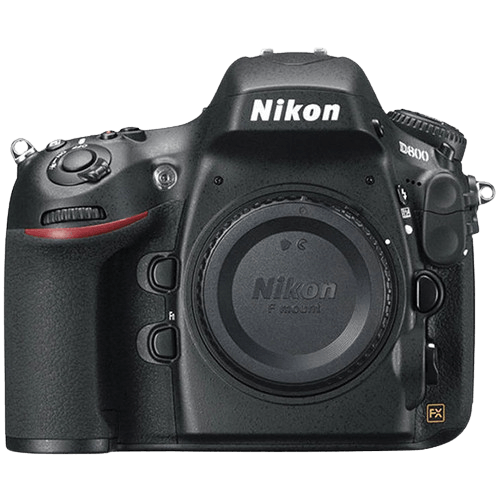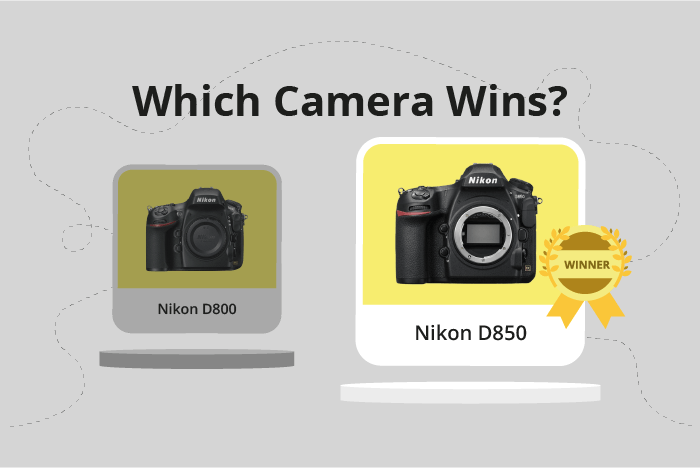Nikon D800 vs D850 Comparison
Nikon D800

Nikon D850

The Nikon D850 outperforms the Nikon D800 with a score of 82/100 compared to 69/100. Both cameras are DSLR models, announced in 2017 and 2012, respectively. They share similar dimensions, with the D850 measuring 146 x 124 x 79mm and weighing 1005g, while the D800 is 146 x 123 x 82mm and 1000g.
The D850’s higher score reflects its improved performance and features. Despite being slightly heavier and more expensive at $3300 compared to the D800’s $2999 launch price, the D850 justifies the extra cost with its advancements in technology.
However, the D800 still holds its ground as a reliable and more affordable option, particularly for those on a tighter budget or just starting in photography.
Ultimately, the Nikon D850 proves to be a superior camera, offering better performance and features to justify its higher price point, while the Nikon D800 remains a decent, budget-friendly alternative.
Nikon D800 vs D850 Overview and Optics
The Nikon D850 emerges as the winner in the optics department, scoring 79/100, compared to the Nikon D800’s 74/100. Both cameras share some key specifications, including a CMOS sensor, full-frame sensor size, Nikon F FX lens mount, and absence of image stabilization. However, the D850 outperforms the D800 in several aspects, while the D800 has some advantages as well.
The Nikon D850’s superiority is evident in its higher megapixel count of 45.7, compared to the D800’s 36.3 megapixels. This difference allows the D850 to capture more detail in images. Additionally, the D850 has a faster shooting speed of 7 frames per second, compared to the D800’s 4 frames per second. This makes the D850 more suitable for capturing fast-moving subjects. Furthermore, the D850 boasts an Expeed 5 processor and a DXOMARK sensor score of 100, compared to the D800’s Expeed 3 processor and DXOMARK sensor score of 95. These factors contribute to the D850’s better overall image quality.
On the other hand, the Nikon D800 does have some advantages, though they are limited in comparison. The D800’s lower megapixel count and slower shooting speed may be suitable for photographers who do not require extremely high-resolution images or rapid shooting capabilities. The D800’s Expeed 3 processor and DXOMARK sensor score of 95 are also respectable, considering its lower price point compared to the D850.
In comparing the optics of the Nikon D800 and D850, the D850 is the clear winner due to its higher megapixel count, faster shooting speed, and superior processor and sensor scores. However, the D800 may still be a viable option for photographers with specific needs and budget considerations.
Nikon D800 vs D850 Video Performance
The Nikon D850 outperforms the Nikon D800 in video capabilities with a score of 70 out of 100, compared to the D800’s 57. Both cameras share some common specifications, such as a maximum video frame rate of 30fps and built-in time-lapse functionality. However, the D850 boasts significant advantages that contribute to its higher score.
The most notable advantage of the D850 is its 4K video resolution, offering a maximum video dimension of 3840 x 2160. In contrast, the D800 only supports Full HD video with a maximum dimension of 1920 x 1080. With the D850’s 4K resolution, users can capture sharper, more detailed footage, making it ideal for professional videography and high-quality content creation.
While the D800 does not have any specific advantages over the D850 in terms of video capabilities, it is worth noting that its Full HD video resolution is still suitable for casual or amateur videographers who do not require the increased detail provided by 4K resolution. The D800’s video quality is satisfactory for general use and sharing on social media platforms.
Taking into consideration the significant difference in video resolution, the Nikon D850 is the clear winner in terms of video capabilities. Its 4K resolution provides a substantial improvement in video quality, making it an excellent choice for professionals and enthusiasts seeking superior video performance. On the other hand, the Nikon D800 offers adequate video quality for casual users, but falls short when compared to the D850’s advanced video features.
Nikon D800 vs D850 Features and Benefits
The Nikon D850 outperforms the Nikon D800 with a feature score of 87/100, a significant 30-point difference from the D800’s 57/100. Both cameras share some specifications, such as a 3.2-inch screen size, no flip screen, no GPS, and WIFI capabilities. However, the D850 surpasses the D800 in several aspects, making it the superior choice for photographers.
The D850’s screen resolution is substantially higher at 2,359,000 dots compared to the D800’s 921,000 dots, providing a clearer and more detailed display. Additionally, the D850 has a touchscreen feature, which allows for more intuitive navigation and control. The inclusion of Bluetooth connectivity in the D850 also gives it an edge over the D800, as photographers can easily transfer images and remotely control the camera through compatible devices.
The D800, on the other hand, does not offer any significant advantages over the D850. Its lower feature score and lack of certain specifications, such as a touchscreen and Bluetooth, make it less appealing to users who seek advanced capabilities in their DSLR cameras.
Taking all these factors into account, the Nikon D850 clearly outshines the Nikon D800 in terms of features and performance. With a higher resolution display, touchscreen capabilities, and Bluetooth connectivity, the D850 offers a more refined and versatile experience for photographers. Although the D800 has some similarities with the D850, it falls short in delivering the same level of innovation and functionality that the D850 provides.
Nikon D800 vs D850 Storage and Battery
The Nikon D850 outperforms the Nikon D800 in storage and battery, scoring 84/100 compared to the D800’s 71/100. Both cameras have two memory card slots and do not support USB charging. However, the D850 accepts SD/SDHC/SDXC (UHS-II compatible) and XQD memory cards, while the D800 accepts SD/SDHC/SDXC (UHS-I compatible) and Compact Flash memory cards. This gives the D850 an advantage in storage options.
In terms of battery life, the D850 clearly surpasses the D800, offering 1840 shots per charge compared to the D800’s 900 shots. The D850 uses an improved EN-EL15a battery, while the D800 uses an EN-EL15 battery. The D800 does not have any advantages in storage and battery over the D850.
Considering these points, the Nikon D850 proves to be a better choice for photographers requiring extended battery life and versatile storage options, while the Nikon D800 falls short in these aspects.
Alternatives to the Nikon D800 and D850
Are you still undecided about which camera is right for you? Have a look at these popular comparisons that feature the Nikon D800 or the Nikon D850:

